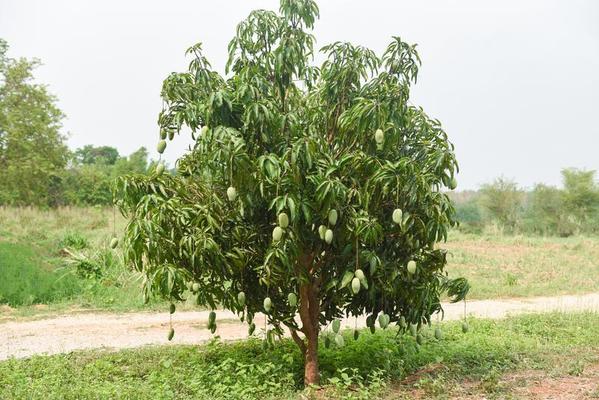Mango Tree

FAMILY: Anacardiaceae
SCIENTIFIC NAME: Mangifera indica L.
ORIGIN: South and Southeast Asia
Description:
Mango trees are deep-rooted, symmetrical evergreens that attain heights of 90 feet and widths of 80 feet. Mango trees have simple alternate lanceolate leaves that are 12 to 16 inches in length and yellow-green, purple, or copper in color when young. Mature leaves are leathery, glossy, and deep green in color. New leaves arise in terminal growth flushes that occur several times a year. Mature terminal branches bear pyramidal flower panicles that have several hundred white flowers that are about a 1/4 inch wide when open. Most of the flowers function as males by providing pollen, but some are bisexual and set fruit. Pollination is by flies, wasps, andbees.
The fruit weighs about 1/4 pound to 3 pounds. Fruit may be round, ovate, or obovate depending on the variety. The immature fruit has green skin that gradually turns yellow, orange, purple, red, or combinations of these colors as the fruit matures. Mature fruit has a characteristic fragrance and a smooth, thin, tough skin. The flesh of ripe mangos is pale yellow to orange. The flesh is juicy, sweet, and sometimes fibrous. Some undesirable seedlings or varieties are described as possessing a turpentine-like off-taste. The fruit has one seed that is flattened and sticks to the flesh. The seed contains one or more embryos depending on the variety or type.
Varieties:
‘Ah Ping’, ‘Fairchild’, ‘Gouveia’, ‘Harders’, ‘Keitt’, ‘Momi K’, ‘Pope’, and ‘Rapoza’ are recommended mango varieties for Hawaii. All the listed varieties are productive and have superior quality fruit. They have less pronounced alternate-year bearing qualities than the more common ‘Haden’ and ‘Pirie’ varieties. All these varieties, including ‘Haden’ and ‘Pirie’, are monoembryonic and do not come true from seed. Flowering occurs from December to April, but offseason flowering is common, resulting in variable harvest times. ‘Fairchild’ is considered somewhat resistant to anthracnose and is favored for humid areas.
‘Exel’ is a high quality mango cultivar developed by the Department of Horticulture, University of Hawaii. It was selected from an open-pollinated population of ‘Irwin’ seedlings. Young ‘Exel’ trees begin to bear three to four years after transplanting into the orchard. ‘Exel’ bears fruit regularly, sets well and frequently flowers during the off season. Fruits usually mature in July and August but in some years, may mature as late as October. ‘Exel’ trees should be planted in sunny, dry areas to prevent anthracnose damage to immature fruit and flowers.
‘Exel’ fruits are ovate, 4 to 5.6 inches in length by 2.8 to 3.6 inches in width, with a short, rounded beak. The average fruit weight ranges from 14.1 to 17.6 ounces. The penduncle is set at the top of the fruit. Immature fruits are green with a purple blush. Mature fruits are yellow with a red over color on about half of the surface of the fruit. The flesh is firm, orange-yellow, juicy, sweet, and fiberless. The fruit has 18% total soluble solids. More than 90% of the fruit is edible flesh, because the fruit has a thin, flat seed.